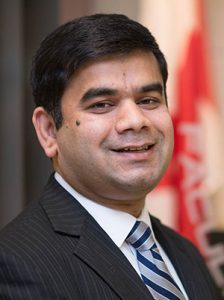
We talk with leading educators and researchers to learn more about the people and topics of asphalt technology.
Dr. Kamal Hossain, Ph.D., PEng is an Assistant Professor at Memorial University in Canada.
What drew you to transportation engineering?
During my undergraduate study in civil engineering in Bangladesh, I chose the structure and transportation option and completed several transportation courses. I still remember Dr. Moazzem’s pavement design and Dr. Zakaria’s asphalt classes. I found those educational, informational and the materials we covered were very practical and we see those applications every time we walk outside. During my graduate studies at the University of Waterloo in Canada, the courses I took in the transportation field also drew my interest. My doctoral project was very practical – investigating the performance of various alternative and conventional anti-icing materials to improve winter road conditions. From there, I fell in love with understanding material behavior, developing performance models and practical applications from research.
What are you learning about North American weather and how it affects asphalt pavements?
By living in Ontario, Illinois and Newfoundland over the past eight years, I can tell you how much the climate can change between the regions and even within a small geographic area. For example, you cannot imagine, how much precipitation we see in Newfoundland – it is either rain, drizzle, fog deposition in summer or snow and flurries in winter. And, you know water is the enemy of asphalt. As the climate can significantly vary, I strongly recommend that every distinct jurisdiction should develop its own asphalt and mix characterization systems. And, they should develop construction specifications relative to their own climate to enhance pavement durability and reduce maintenance costs.
Which performance prediction models are you finding work best with asphalt?
Being an early-career researcher, I feel like there are already many developments and models in asphalt performance analysis and the asphalt community is continuously trying to further these developments. This is excellent but can easily be confusing to select “the best.” I think the pavement community needs to continuously review and publish those models in each sector of pavement engineering for greater benefits of the whole community, stakeholders and beyond – to have an impact worldwide. Remember, infrastructure is the highest consumer of tax dollars.
How will energy harvesting in smart asphalt pavements change the way we construct roads?
The world has over 64 million kilometers of road. I like the idea that we need to try to use these roads for a secondary purpose. Harvesting energy from the road, although it is a relatively new idea, is the right direction to move forward in my opinion. Therefore, the government sector should undertake more research initiatives to advance this idea and generate knowledge in this area. Questions to ask include “how can we adapt our asphalt mixture to accommodate piezoelectric semiconductors”, “can we use ‘larger aggregates’ in the surface mixes”, “what will be the pavement maintenance implications on mixtures with semiconductors” and – above all “what will be the cost-benefit analysis?” Lots of questions need to be asked and then answered through research before this becomes a mass scale initiative.
Where should today’s students focus their asphalt research?
From a topical perspective, I think today’s researchers should work on the further development of technologies that can help understand asphalt performance better, quicker and more economically. In addition, I think we need to research how to design pavements to be more resilient to the impacts of climate change. Another area is the adaptation of our pavement design, construction and management system for a new generation of autonomous and electric vehicular traffic. And, whatever the topics they work on, they need to couple their research with practical applications.














